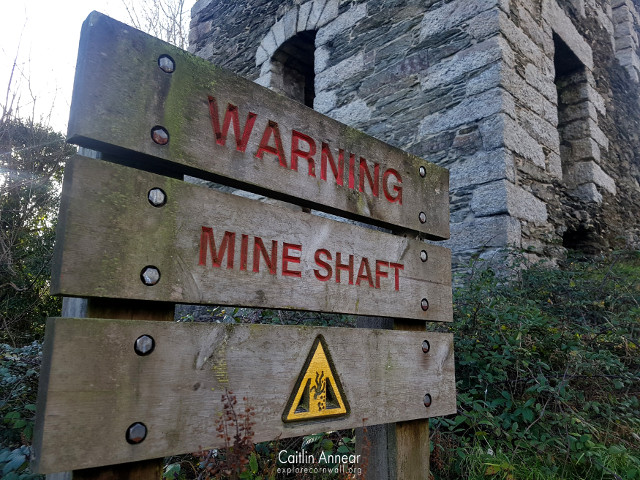Up above Twelveheads stands the two engine houses and single stack of Cusvey mine. The mine was first worked for tin between 1734 and 1764, before becoming a very prominent copper mine alongside its neighbour Wheal Fortune.
Cusvey was forced to close following the global slump in copper prices, but reopened as part of Consolidated mines in 1819. The mine closed again in 1857, where it later became part of Clifford Amalgamated before its final closure in 1870.
The Wheal Jane group did some explorations and digging around in the late 20th century, but apart from that it has been left to overgrow and fall down until it was consolidated in 2009 as part of the cycle/tram route.

Shear’s pumping engine house, built in 1826 (maybe), is potentially one of the oldest engine houses remaining in Cornwall. Originally built for a 70″ engine, this was later replaced with a smaller 65″ engine. It’s boiler house was somewhere to the north. The pumping engine pumped out of Shear’s shaft (150 fathoms/274m) right in front of it.

Remains of the calciner flue can be seen hidden amongst the bushes and brambles. The calciner is likely to have burnt off the arsenic as waste rather than for collection and selling. The chimney just behind the pumping engine house was also built around 1826 and would have served both engine houses on the site and possibly a calciner somewhere further down the hill.

Remains of the winding engine house hidden in the Cornish jungle. This house was actually built before the pumping engine and is a rare find as its beam was houses inside the engine house. The whim worked a separate shaft slightly to the east; this has been left by the council to become overgrown and obscured to restrict public access. East shaft reached 100-fathoms (183m).

Since the Mineral Tramways project, the whole area has been consolidated and made safer. There’s a public footpath up from the Consols/Mount Wellington tailings – it was quite narrow and bramble-y when I went up last time. The area is still pretty overgrown, especially the whim engine.
There is free parking in Twelveheads.
Acton, B. (2000) Exploring Cornwall’s tramway trails. Vol. 2. Truro: Landfall Publications.
Brown, K. and Acton, B. (2007) Exploring Cornish Mines: Volume One. 4th edn. Truro: Landfall.
Cornwall Council (2004) Mineral Tramways Conservation Management Plan. Available at: http://map.cornwall.gov.uk/reports_event_record/2004/2004R066.pdf.
Nance, D. and Brown, K. (2014) A complete guide to the engine houses of West Cornwall. Gloucestershire: Lightmoor Press.
